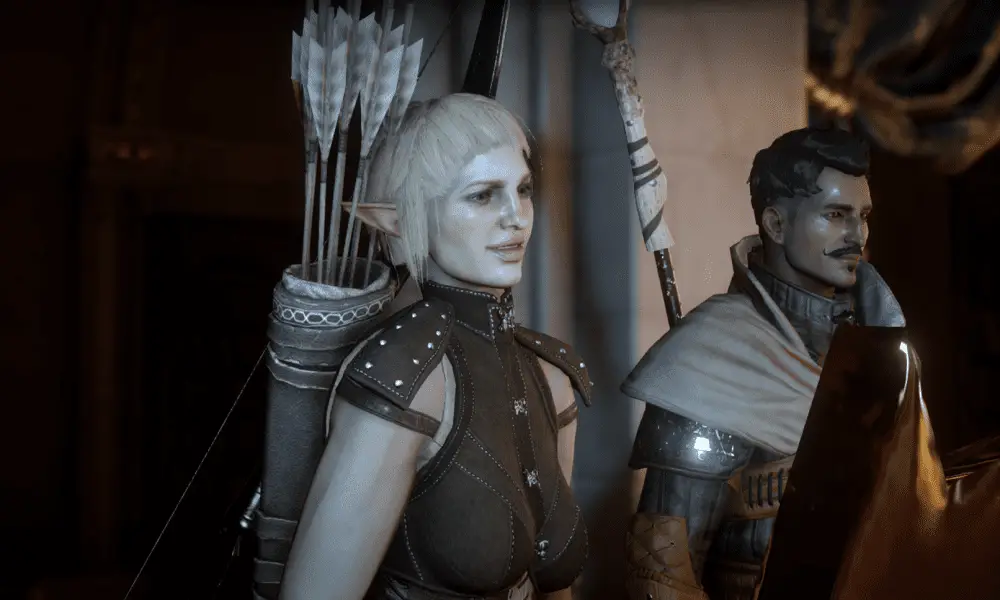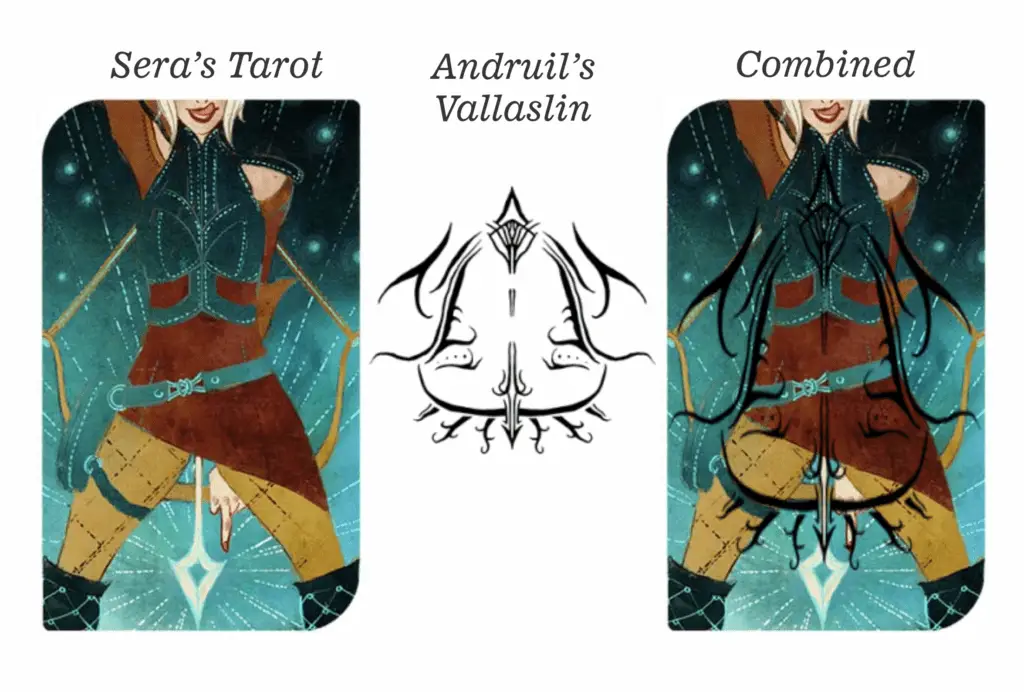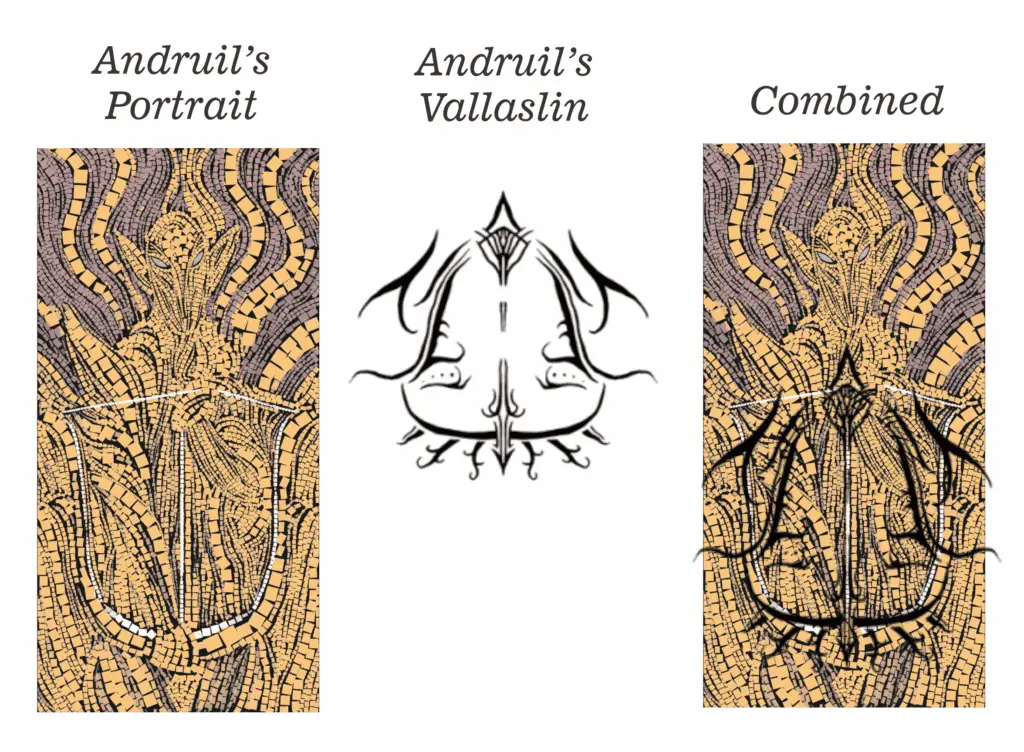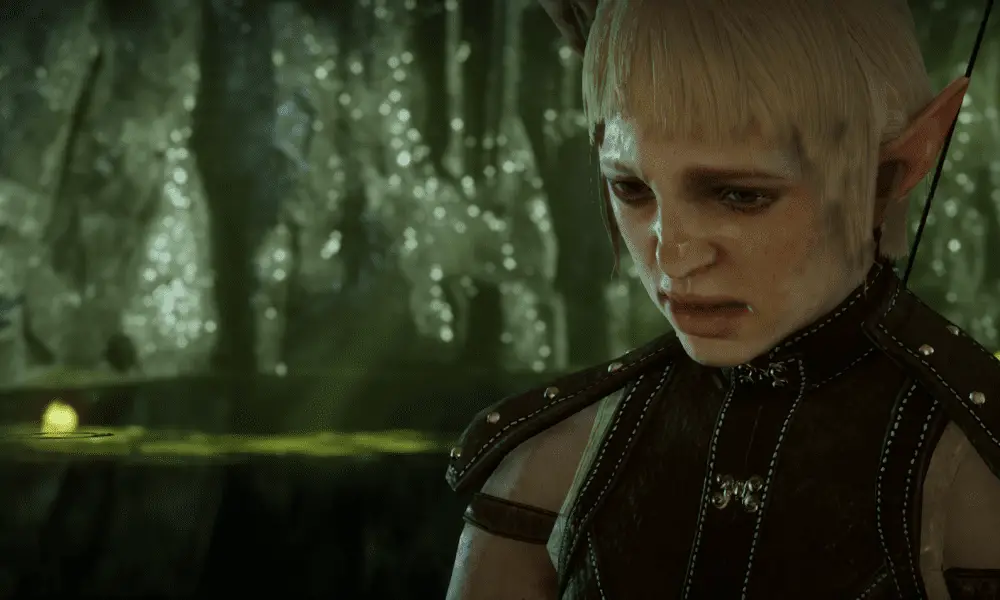Spoiler Warning for all of Dragon Age: Inquisition
Solas: We are not so far apart, you and I.
Sera: We will be.
Funny, brash, and maddening, Dragon Age: Inquisition‘s Sera can be both charmingly sweet and occasionally, breathtakingly cruel. She’s the impudent friend who’s spent her life thieving (but who, like Robin Hood, never forgets to champion the little people), who drinks herself under the table, flashes her ass at prim and proper Vivienne, and who jokes with Bull and Blackwall. She also taunts Solas constantly—not for his secrets, but ironically, simply for embracing a shared heritage she has refused to acknowledge in herself.
However, Sera, out of all our companions, cares most about the common people of Thedas’s world—the poor and abused who suffer most during the appearances of Breaches and Blights (although she has a definite fondness for breeches of another kind). Sera thumbs her nose at propriety, is wary about getting too close to people, hates her own “elfyness,” and also deeply dislikes people writing songs about her skills at thievery and archery. Do that, and you just might get a lute over your head.
However, what’s even more interesting about Sera is that while she hates and fears her own elven heritage, there are several mysterious hints within Dragon Age: Inquisition that she may in fact, like Flemeth, carry a spark of the Evanuris (ancient elven immortals) within her—specifically, in Sera’s case, the “wisp” of the elven goddess of the hunt, Andruil. (Note: This has been a popular topic of discussion across the Dragon Age fanverse, so I definitely want to credit Shaylyn Ispan, who started the discussion following some early Bioware posts. Her original post and analysis is not only detailed and worth reading, it also includes the very first fantastic revelations of the Andruil Vallaslin superimposed over Sera’s Tarot card, which I’ve recreated here on my own, using clearer images direct from Bioware.)
The Early Parallels
According to the tales and scraps of information we uncover in Dragon Age: Inquisition as well as across its Codices and DLCs (especially “Trespasser”), the ancient Elvhen goddess Andruil was a superb archer, creating what was known as the “Vir Tanadhal,” or “The Way of Three Trees.” This Way involved three branches: The Vir Assan (“Way of the Arrow,” a directive to, per the Dragon Age Wiki, “fly straight and do not waver”; the Vir Bor’assan (“The Way of the Bow,” to bend without breaking), and last but not least, the Vir Adahlen, or “Way of the Forest,” which involves the acceptance of the gifts of the hunt with humility and compassion.
Let’s apply these to Sera: she lives and breathes the Way of the Arrow (“Arrows!” is literally her answer to most quandaries), she’s a survivor, bending without breaking, and she gives generously of the hunt with compassion to the humblest in Thedas. These paths also all apply equally well to Sera’s underground organization The Red Jennies, as well.
In other words, Sera shares many similarities with Andruil right off the bat: she’s a superb natural archer whose abilities are commented on with amazement (along with the reminders that she achieved this with little to no training), she’s both compassionate to the “little people,” but also cranky and distrustful of authority figures. She’s more comfortable on her own than in a group. Like Andruil, Sera is quite willing to act mercilessly in vengeance, and like the huntress, she does so swiftly and brutally.
Also like Andruil, whose beloved was a woman named Ghilan’nain, Sera is a lover of women. While Andruil (as strongly implied by the DAI Codices) was bisexual, as she also slept with men (and most notably attempted to enslave the Dread Wolf to her bed for a year), I do think the parallel is a significant one. Sera also prefers a life that’s fierce and free, untethered. Andruil’s ambitions eventually drove her mad, and here again, Sera shows more than an occasional hint of mental instability, and even (touchingly) a fear of her own thoughts, dreams, and inner self.
Gods Versus Gods
Another way Sera resembles Andruil is in her antagonism toward specific characters. Just as Andruil once actively fought against Fen’Harel directly on more than one occasion, Sera clashes constantly and adversarially with Solas. Not only does this bring up the potential subtext of the constant battles between Andruil and Fen’Harel, but they also potentially exemplify the raging of Andruil against Fen’Harel’s own kingdom: The Fade. In which case, it’s tempting to think that Sera not only literally fears her own dreams (most evident in a romance with a female Inquisitor), she is also terrified of the Fade even as a physical landscape (as she expresses if you bring her with you to Adamant). For Sera, there is no respite in dreams.
As well as clashing bitterly with Fen’Harel, Andruil also fought (literally and figuratively) many times with Mythal, so this is probably a good moment to mention that the dragon is Mythal’s symbol (and alter ego Flemeth’s shapechanging form). Sera’s also curiously drawn to fighting dragons—enough so that she comments on it several times within the game dialogue, and there is even a note about Sera’s curious attraction to them in her Codex entry.
Another potential similarity between the two is the fact that Sera’s greatest fear (as we discover in the Fade) is simply “nothingness” or “nothings.” What was Andruil’s greatest feat? Entering the forbidden Void in order to hunt the Forgotten Ones—a feat that drove her mad. Eventually Mythal intervened and removed all knowledge of the Void’s location from Andruil’s mind. And even this memory loss is fascinating, since Sera rather abruptly admits that she doesn’t remember her actual family or early childhood at all. Just that she was present at the alienage until her rescue by her adoptive human mother.
Sparring with Solas
And this is where it gets really interesting, to me. My feeling that Sera has an inner magic or presence isn’t just based on her outer similarities to Andruil, but on her own acknowledgment that there’s something else going on within her that scares her to death.
Interestingly enough, the person who brings this out in her? Solas. In her conversations with Solas in the game’s banters, Sera suddenly shows outright terror and disturbance at something she can’t define (she is shaking visibly). Solas asks her what’s happening, and this is the conversation that follows:
Sera: Weird.
Solas: Sera? What are you feeling?
Sera: Ugh, here we go. It’s nothing, it just feels like I’ve seen this. Exactly this. It happens.
Solas: Not to everyone.
Sera: It’s not an elf thing. Inquisitor’s not shaking (alt: You’re not shaking). I suppose now you’ll switch to how I’m the same but different?
Solas: You are different. You are the furthest from what you were meant to be.
Sera: Well I’ve definitely heard piss like this before. Hmph!
This is one of my favorite banters across the game—the moment in which Solas, quietly and without doubt, says to her, “You are the furthest from what you were meant to be.” As if he knows exactly what or where that is.
This moment is echoed again in a later banter, this time with Cole, as Sera feels that strange sense of deja vu again:
Sera: Have we been here? I mean right here, doing exactly this? It feels weird.
Cole: Yes. But not how you mean. In the soft thin places, spirits push with memories that didn’t happen. Or did. Or might.
Meanwhile, Solas is even able to get Sera to expound on these moments later on, despite her unwillingness to engage with him:
Solas: What color is the sky when you look at it?
Sera: You know, blue mostly. Except for the Breachy bits.
Solas: And when you looked past the Breach? As perhaps you were drawn to do?
Sera: Greenish? Then clear a long ways, and kind of… felt like falling. Ugh! Makes my head hurt. You make my head hurt.
Solas: We are not so far apart, you and I.
Sera: We will be.
Solas makes several similar references in the course of his conversations with Sera—that Sera is far from herself, that she is “apart,” and sundered from who she was meant to be. Is Andruil who she was meant to be? A proud elf, fierce and free, a hunter of men and beasts alike?
Calls From Past Millennia
Remember Flemeth’s dialogue with Morrigan in the Fade near the end of the game? About the wisp of Mythal’s awareness that became part of her, and of how a soul cannot be forced upon the unwilling? I think this is hugely important—not just to Solas’s story, but also potentially to Sera’s.

Is Sera hearing the voice of Andruil somewhere deep inside? Could that actually be part of why she rejects and fears her own elven heritage? Millennia back, Mythal was murdered by the Evanuris—the act that caused Solas (Fen’Harel) to create the Veil, imprison the Evanuris (who were enslaving their own kind, while also making a pretty fair attempt at conquering the world), and to inadvertently damn or destroy the very people he was trying to save, the elves, for ensuing millennia.
Mythal’s consciousness, however, continued to live, until (centuries before the events of DAI), she made her presence known to Flemeth, a witch howling with loss, rage, and a desire for vengeance against men. Flemeth heard and accepted Mythal’s presence as a kind of wakened subconscious, a new teammate in her desire to take retribution (and, I feel, once her anger had cooled, to “nudge” the events of men now and then in the right direction).
Mythal’s presence in Flemeth elevated the witch to something more than mortal, and she lived for centuries, arising even from death (if killed in her dragon form in DAO) only to live again in DA2 and DAI, providing rescue, counsel and insight at key moments.
Love and Death Among Immortals
From a writing standpoint, I think Mythal clarified this for us in the scene with Morrigan in DAI so that there was no mistake about the final scene in the epilogue between Flemeth and Solas (also a scene between Mythal and Fen’Harel, of course).
There, we see Flemeth send another of those familiar “wisps” of soul into her eluvian, then she simply, calmly awaits Solas. As I addressed here in my previous analysis, when Solas arrives, their reunion is sorrowful and loving. Solas even notes that he is the one who should pay, but that he cannot leave his task undone. Mythal, meanwhile, seems to be nothing but supportive. She is either actively cooperative or passive as Solas then, sorrowfully, takes the wisp of life from Mythal. That light instantly glows in his own eyes, over her apparently lifeless body, but that still doesn’t account for that wisp she sent through the Eluvian, so I’m totally in the camp going, “Flemeth/Mythal’s not dead, guys” (and it’s echoed again, smilingly by Solas in “Trespasser,” when he admits, “The first of my people are not so easy to kill”).
So, basically, Solas got a huge power-up (and I’d imagine the life of a goddess to be a significant boost, judging from his seriously terrifying powers in “Trespasser”). And as I mentioned before, I like that the scene is presented so lovingly—it’s actually sadder and more disturbing that way, and foreshadows the deep love between them that we hear about later in “Trespasser.”
But let’s get back to Sera—and here’s where it gets interesting (again).
Wisps and Arrows, Souls and Voices
I believe if Andruil is present in Sera, that she’s a soft, subliminal presence. She’s somewhere beneath (in the Void?), around the edges, not so much a full persona as a whisper or an echo.
And to me this is also fascinatingly apparent if we compare Sera’s Tarot card (her avatar image from within Dragon Age: Inquisition) to the vallaslin (Dalish face-tattoo) of Andruil (which Dalish players can choose to wear as part of their character creation). The parallels between Andruil’s vallaslin and Sera’s Tarot image, recreated by me here from the original idea by Shaylyn Ispan, are undeniable. And then there are the further echoes and parallels when we compare those with the same vallaslin-image superimposition using Andruil’s portrait from the Temple of Mythal (please note that as Shaylyn did originally, the vallaslin is flipped vertically).


An Accidental Pairing (“No Soul is Forced Upon the Living…”)
And yet these are, still, shadowy and soft. I do not think Sera is Andruil, precisely. But I think Andruil may lie within her, whispering or sleeping.
Sera isn’t Flemeth, who in a bid for power willingly, and in full awareness, accepted the wisp or spark of Mythal’s soul. The Flemeth who further emphasizes, later on to Morrigan, that there is no real possession involved in the process and that it’s entirely voluntarily (“No soul is forced upon the living. You were never in danger from me.”). Flemeth later takes a similar wisp or spark from Kieran if present (presumably, the spark of the Old God Soul created in him if and when Morrigan did the Dark Ritual back in DAO). Kieran’s wisp is one that I actually think may be more like Sera’s—it didn’t seem to be a possessive consciousness for him so much as an additional awareness. (When Flemeth takes it, Kieran does express regret to Morrigan that he will be lonely now, once the wisp is gone.)
In addition, remember that it’s been established that the first of the Evanuris, at least, Mythal (and perhaps more), can speak to mortals in dreams, as we hear that Mythal has done after the game has ended if we go back to Val Royeux. Once there, we can hear a woman talking confusedly about her dream-conversations with someone called Mythal. So once again, Mythal has defeated death (and is definitely not gone for good).
So what about Sera? Sera would never actively accept this kind of soul-subletting, not least with an ancient elven goddess. No way, no how.
A Whisper of a Presence (and a Tie to the Fade?)
With this in mind, my feeling is that Andruil is a dormant, and probably inadvertent, trapped part of Sera’s soul or subconscious—latent, not active, just whispering to her in dreams and perhaps around the edges of her life. For me, it’s almost as if Sera is a distant reincarnation of Andruil, with her most distinctive traits mirroring those of the goddess even as she remains her own person. So she’s a superb, almost preternatural, archer and huntress. She is a woman who loves women. She’s subversive yet strongly traditional, actively opposing both the dragon (Mythal) and the wolf (Solas).

So my guess is that it’s only around the very edges of Sera’s life that Andruil whispers her presence—in dreams (another reason for Sera to hate and fear the Fade), or as when Sera grows dizzy looking into the Rifts, or when delving into herself for magic. But if Solas brings down the Veil… it’s interesting to wonder what might happen to Sera, then. A Sera with magical abilities and full inner vision.
Meanwhile, Cole also makes some very interesting observations that may denote Sera’s inner divine spark as well, as when he tells her, “There are songs in every part of you, Sera. Soft silly sibilant, sighing in silence, waiting for you to hear them.” Sera, in response, furiously refuses to listen further.
This would also ultimately explain Solas‘s constant fascination with Sera—a fascination that isn’t romantic but which does appear to be intense and almost eager. As a person who is deeply lonely, with no companions from his era save Flemeth (who appears to have distanced herself (at least for a while, after the disaster of the Orb and the Temple of Sacred Ashes), Solas would certainly be eager to see potential connections with his lost companions—even those who opposed him.
Does Solas therefore see the echoes of Andruil, his old antagonist, in Sera, and seek to draw her out in his loneliness and desire to reconnect with his ancient people? Even if, as is implied, he brought about her eternal imprisonment in harsh vengeance?
It’s a really interesting thought. My guarded answer right now is… Yes. I think he does.
It also provides another really believable answer for why Sera is so antagonistic to Solas, yet also why she is consistently drawn to answer him truthfully. He is pulling abilities and visions out of her that frighten her and that she does not want awakened.
This is why I believe Solas remembers Andruil when he looks at Sera, and marvels: “You are different. You are the furthest from what you were meant to be.”
It’s both sad and believable how, to Sera, this sounds like the Dread Wolf’s worst curse of all.
Images courtesy of Bioware
This article is a reprint (with minor modification and expansion) of an article originally published by Angela D. Mitchell on DumpedDrunkandDalish.com.

